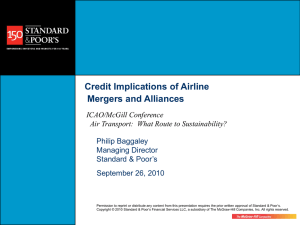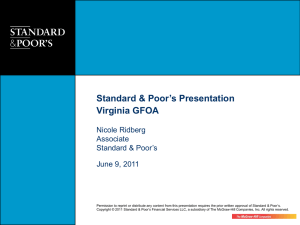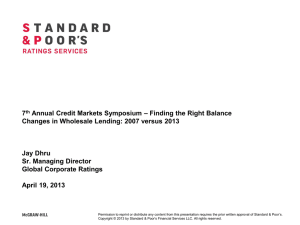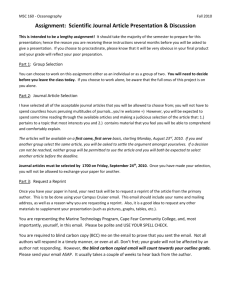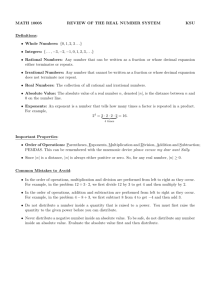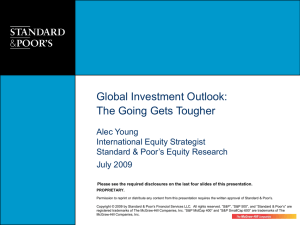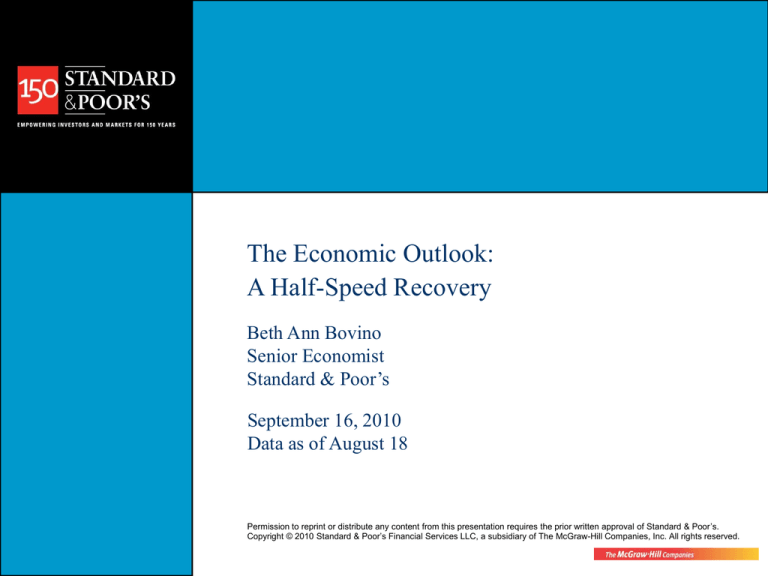
The Economic Outlook:
A Half-Speed Recovery
Beth Ann Bovino
Senior Economist
Standard & Poor’s
September 16, 2010
Data as of August 18
Permission to reprint or distribute any content from this presentation requires the prior written approval of Standard & Poor’s.
Copyright © 2010 Standard & Poor’s Financial Services LLC, a subsidiary of The McGraw-Hill Companies, Inc. All rights reserved.
The U.S. Hits Bottom
• The recession appears to have ended in the third quarter of 2009
• Housing had been in recession for three years,
• But seems to be stabilizing.
• Overseas partners are recovering, helping exports,
• But the dollar strength has hurt the trade deficit
• The fiscal stimulus has helped boost the economy, but will be
withdrawn in 2011
• The financial system appears to be stabilizing.
• But private nonresidential construction is still plunging.
• The recession has been the longest and deepest since the WW II.
• And the recovery is likely to be slow and uneven.
• Another dip into recession is possible if the financial markets lock up
again, oil prices jump, or consumers remain scared.
Permission to reprint or distribute any content from this presentation requires the prior written approval of Standard & Poor’s.
2.
The Housing Market Cycle
(Housing starts (1000) and 12-month % change in home prices (S&P/Case-Shiller))
2,500
30
2,000
20
1,500
10
1,000
0
500
0
1990
-10
-20
1993
Starts
1996
1999
2002
2005
Home prices (%chya, right)
Source: Standard & Poor’s and Census Bureau
Permission to reprint or distribute any content from this presentation requires the prior written approval of Standard & Poor’s.
3.
2008
Those Who Bubbled Highest Burst Loudest
(Percent increase in S&P/Case-Shiller home price index, May 2010)
20-city Average
Miami
Los Angeles
Washington
San Diego
Tampa
Las Vegas
Phoenix
New York
San Francisco
Seattle
Portland
Boston
Minneapolis
Chicago
Denver
Atlanta
Charlotte
Detroit
Dallas
Cleveland
-100
-50
0
2000-peak
50
100
peak-present
Source: Standard & Poor’s
Permission to reprint or distribute any content from this presentation requires the prior written approval of Standard & Poor’s.
4.
150
200
The Fed Didn’t Stop At Nothing
(Percent)
10
8
6
4
2
0
1995 1997 1999 2001 2003 2005 2007 2009 2011 2013
Federal Funds Rate
10-Yr Bond Yield
Source: Federal Reserve
Permission to reprint or distribute any content from this presentation requires the prior written approval of Standard & Poor’s.
5.
Mortgage rate
Quality Spreads Are Narrowing From Record Highs
(Spread over Treasury yields, percentage points)
Source: Standard & Poor’s Global Fixed Income Research
Permission to reprint or distribute any content from this presentation requires the prior written approval of Standard & Poor’s.
6.
All Fall Down
(Percent change in real GDP, quarterly rate)
Source: Global Insight
Permission to reprint or distribute any content from this presentation requires the prior written approval of Standard & Poor’s.
7.
Deficits Are Mostly Cyclical
(Government deficit as % of GDP, fiscal years)
Source: Standard & Poor’s.
Permission to reprint or distribute any content from this presentation requires the prior written approval of Standard & Poor’s.
8.
Weaker Employment Is Hurting Construction
(4-quarter percent change)
4%
3%
2%
1%
0%
-1%
-2%
-3%
-4%
-5%
1990 1992 1994 1996 1998 2000 2002 2004 2006 2008 2010 2012
Employment
Nonresidential construction (right)
Source: Bureau of Labor Statistics, Bureau of Economic Analysis, S&P projections
Permission to reprint or distribute any content from this presentation requires the prior written approval of Standard & Poor’s.
9.
40%
30%
20%
10%
0%
-10%
-20%
-30%
-40%
-50%
Can the Consumer Keep Spending?
• Consumer spending led recent expansions
• But wealth is down because home prices have dropped and
• Stocks are still down from their 2007 peak
• Borrowing is more difficult, and home equity loans much
less available
• Confidence has dropped and unemployment risen
• Consumers are likely to continue to save more and
borrow less
• Falling oil prices gave back some purchasing power, but that is
now reversing
• Stimulus package provides some income boost
Permission to reprint or distribute any content from this presentation requires the prior written approval of Standard & Poor’s.
10.
Debt Is Dropping From Record Highs
(Percent of after-tax income)
10
140%
8
130%
6
120%
4
110%
2
100%
0
90%
-2
1990 1993 1996 1999 2002 2005 2008 2011
Saving rate
Debt/income (right)
Source: Bureau of Economic Analysis and Federal Reserve
Permission to reprint or distribute any content from this presentation requires the prior written approval of Standard & Poor’s.
11.
80%
High Unemployment Scares Consumers
(Percent)
130
120
110
100
90
80
70
60
50
2000
11
10
9
8
7
6
5
4
3
2003
2006
Consumer sentiment
2009
2012
Unemployment Rate (right)
Source: Bureau of Labor Statistics and University of Michigan Survey Research Center
Permission to reprint or distribute any content from this presentation requires the prior written approval of Standard & Poor’s.
12.
Unemployment Rates Are High
(July 2010)
Under 8%
8% to 9%
9% to 10%
10% and over
Source: BLS
Permission to reprint or distribute any content from this presentation requires the prior written approval of Standard & Poor’s.
13.
Wealth Slides With Home and Stock Prices
(Percent of after-tax income)
700%
600%
500%
400%
300%
200%
100%
0%
1990 1993 1996 1999 2002 2005 2008
Net worth
Financial assets
Source; Federal Reserve
Permission to reprint or distribute any content from this presentation requires the prior written approval of Standard & Poor’s.
14.
2011
Car Sales And Housing Starts Hurt Most
(Millions of units)
3
20
2.5
18
2
16
1.5
14
1
12
0.5
10
0
1993 1996 1999 2002 2005 2008
Housing starts
8
2011
Car sales (right)
Source: Census Bureau, Global Insight
Permission to reprint or distribute any content from this presentation requires the prior written approval of Standard & Poor’s.
15.
Bottom Line: The Economy Will Recover Slowly
• The recession is the longest and deepest since the 1930s
• Fiscal stimulus will support the recovery
• But recovery is likely to be slow because of financial markets
and switch to higher savings
• If financial markets lock up again
• Home prices continue to fall
• And oil prices continue to rise
• The recession could be longer and deeper
• With the risk of a “lost decade” similar to Japan in the 1990s
Permission to reprint or distribute any content from this presentation requires the prior written approval of Standard & Poor’s.
16.
www.standardandpoors.com
Copyright © 2010 by Standard & Poor’s Financial Services LLC (S&P), a subsidiary of The McGraw-Hill Companies, Inc. All rights reserved. No content (including ratings, credit-related
analyses and data, model, software or other application or output therefrom) or any part thereof (Content) may be modified, reverse engineered, reproduced or distributed in any form by
any means, or stored in a database or retrieval system, without the prior written permission of S&P. The Content shall not be used for any unlawful or unauthorized purposes. S&P, its
affiliates, and any third-party providers, as well as their directors, officers, shareholders, employees or agents (collectively S&P Parties) do not guarantee the accuracy, completeness,
timeliness or availability of the Content. S&P Parties are not responsible for any errors or omissions, regardless of the cause, for the results obtained from the use of the Content, or for the
security or maintenance of any data input by the user. The Content is provided on an “as is” basis. S&P PARTIES DISCLAIM ANY AND ALL EXPRESS OR IMPLIED WARRANTIES,
INCLUDING, BUT NOT LIMITED TO, ANY WARRANTIES OF MERCHANTABILITY OR FITNESS FOR A PARTICULAR PURPOSE OR USE, FREEDOM FROM BUGS,
SOFTWARE ERRORS OR DEFECTS, THAT THE CONTENT’S FUNCTIONING WILL BE UNINTERRUPTED OR THAT THE CONTENT WILL OPERATE WITH ANY
SOFTWARE OR HARDWARE CONFIGURATION. In no event shall S&P Parties be liable to any party for any direct, indirect, incidental, exemplary, compensatory, punitive, special or
consequential damages, costs, expenses, legal fees, or losses (including, without limitation, lost income or lost profits and opportunity costs) in connection with any use of the Content even
if advised of the possibility of such damages.
Credit-related analyses, including ratings, and statements in the Content are statements of opinion as of the date they are expressed and not statements of fact or recommendations to
purchase, hold, or sell any securities or to make any investment decisions. S&P assumes no obligation to update the Content following publication in any form or format. The Content
should not be relied on and is not a substitute for the skill, judgment and experience of the user, its management, employees, advisors and/or clients when making investment and other
business decisions. S&P’s opinions and analyses do not address the suitability of any security. S&P does not act as a fiduciary or an investment advisor. While S&P has obtained
information from sources it believes to be reliable, S&P does not perform an audit and undertakes no duty of due diligence or independent verification of any information it receives.
S&P keeps certain activities of its business units separate from each other in order to preserve the independence and objectivity of their respective activities. As a result, certain business
units of S&P may have information that is not available to other S&P business units. S&P has established policies and procedures to maintain the confidentiality of certain non–public
information received in connection with each analytical process.
S&P may receive compensation for its ratings and certain credit-related analyses, normally from issuers or underwriters of securities or from obligors. S&P reserves the right to disseminate
its opinions and analyses. S&P's public ratings and analyses are made available on its Web sites, www.standardandpoors.com (free of charge), and www.ratingsdirect.com and
www.globalcreditportal.com (subscription), and may be distributed through other means, including via S&P publications and third-party redistributors. Additional information about our
ratings fees is available at www.standardandpoors.com/usratingsfees.
Permission to reprint or distribute any content from this presentation requires the prior written approval of Standard & Poor’s.
STANDARD
& POOR’S and S&P are registered trademarks of Standard & Poor’s Financial Services LLC.
17.


